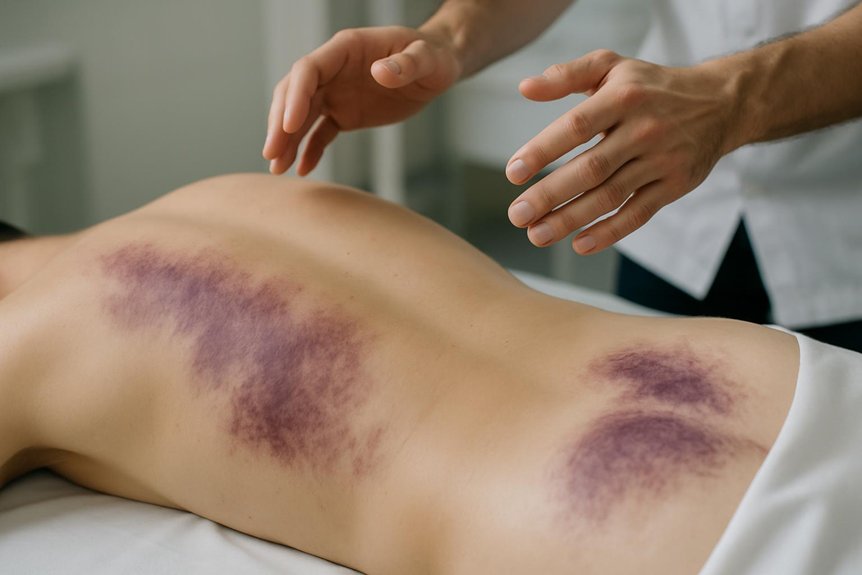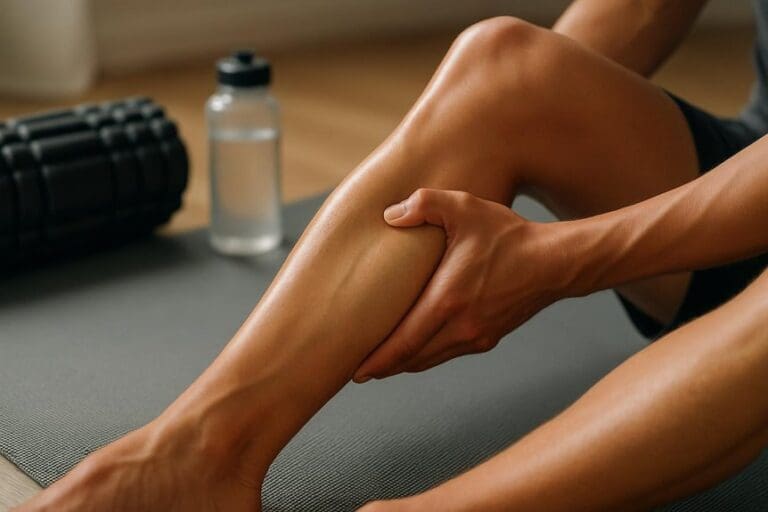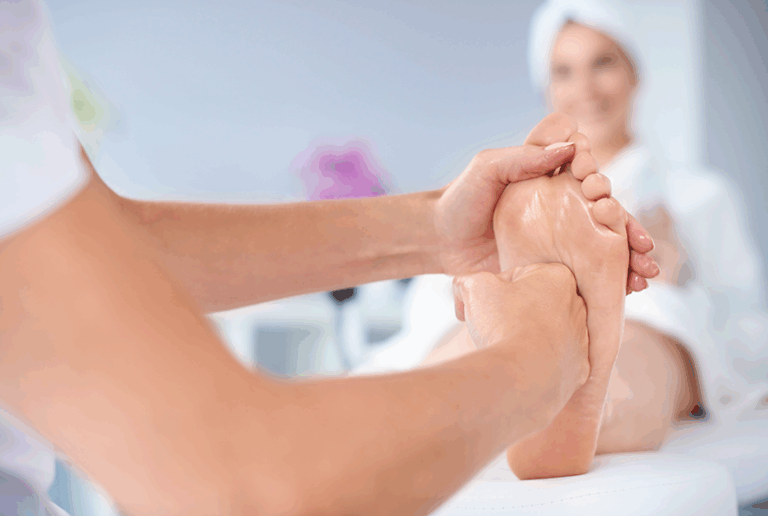Yes. It can cause bruising when sustained pressure compresses superficial capillaries, especially over bony areas or in fragile tissues. Mechanical shear and prolonged load may induce microvascular leakage. Risk increases with age-related skin thinning, anticoagulants, antiplatelets, SSRIs, fish oil, nutritional deficits, and connective tissue disorders. Proper technique—gradual warming, graded pressure, and real-time feedback—reduces likelihood. Typical soreness is diffuse; focal, persistent discoloration suggests bruising. Guidance on prevention, aftercare, and when to seek medical advice follows.
Understanding It and How It Works
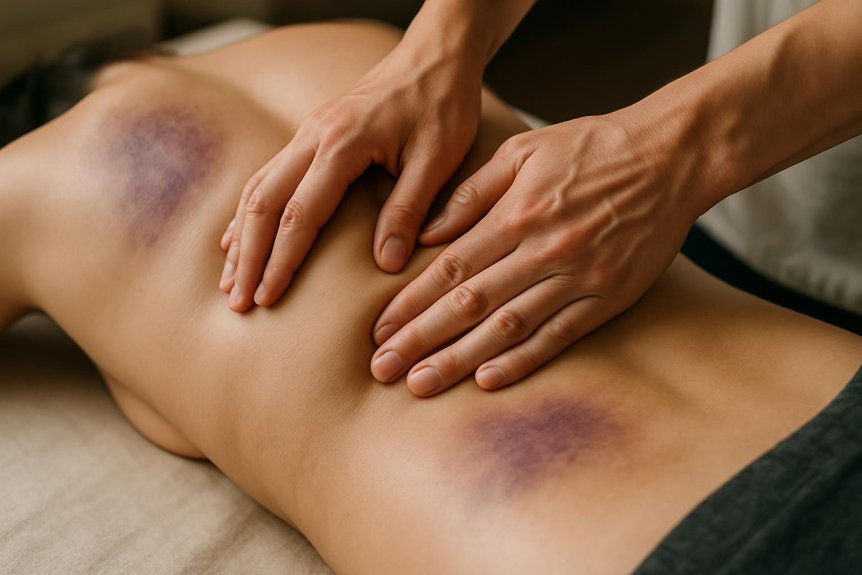
How does deep tissue massage exert therapeutic effects on musculoskeletal structures? It applies sustained, well-graded pressure to engage deeper myofascial layers, targeting adhesions, hypertonic bands, and trigger points. Mechanically, slow strokes and compressions induce viscoelastic deformation, improving tissue glide and range of motion.
Neurophysiologically, stimulation of mechanoreceptors modulates nociception via spinal gating and descending inhibition, easing protective guarding. Increased local perfusion supports metabolic exchange and recovery.
At Spa & Massage clinics in London, therapists assess posture, palpate tissue texture, and calibrate pressure to client tolerance, using forearms, knuckles, and elbows with hypoallergenic oils to reduce shear. Sessions prioritise steady pacing, diaphragmatic breathing, and clear consent cues, fostering safety and closeness.
Guidance includes hydration, gentle mobility, and heat application to sustain gains. In addition to its role in pain relief, this massage offers therapeutic benefits such as reduced muscle tension and improved functional movement.
Why Bruising Can Happen After a Massage
Bruising after therapeutic deep massage can occur when sustained pressure compresses soft tissues and transiently disrupts superficial capillaries, producing minor subcutaneous bleeding.
Tissue response varies with load, rate, and technique, so identical pressure can yield different outcomes across muscle groups.
Individual susceptibility—age, medications (e.g., anticoagulants), nutritional status, and history of easy bruising—modulates risk, which our therapists at Spa & Massage assess to tailor pressure and pacing safely.
Pressure and Tissue Response
Why does deep pressure sometimes lead to visible marks? Deep tissue techniques apply sustained force to reach fascia and adhesions, compressing capillaries and mechanically stressing endothelial walls. When local pressure exceeds capillary tolerance, microvascular leakage occurs, allowing erythrocytes to enter interstitial spaces and create ecchymosis.
Shear forces from slow, deliberate strokes can also disrupt fragile perivascular tissues, especially where muscle overlays bone.
At Spa & Massage, therapists modulate load, angle, and stroke speed to achieve therapeutic deformation without unnecessary tissue strain. They warm tissues first, then increase depth gradually, monitoring skin color, tissue recoil, and client feedback in real time.
When mild redness appears, they pause or vary technique—using melting pressure, cross-fibre friction sparingly, and precise pacing—to encourage circulation, reduce adhesions, and minimise capillary stress while maintaining a caring, attentive touch.
Individual Bruise Susceptibility
A client’s propensity to bruise after deep tissue work varies widely due to intrinsic and extrinsic factors that influence capillary integrity and hemostasis. Age-related dermal thinning, fair or delicate skin, low subcutaneous fat, and genetic traits (e.g., Ehlers–Danlos spectrum) elevate risk.
Systemic variables—iron deficiency, low vitamin C, estrogen fluctuations, and high training load—can weaken vessel resilience. Medications and supplements that impair clotting (anticoagulants, antiplatelets, SSRIs, fish oil, ginkgo, garlic) further increase susceptibility.
At Spa & Massage, therapists screen for these factors, adapt pressure gradients, and employ slower, sustained techniques to reduce shear. When needed, they prioritise myofascial or Swedish sequences over aggressive friction.
Post-session, clients are advised gentle compression, elevation, and cool packs. Open dialogue about comfort thresholds allows precise, therapeutic intensity without unnecessary bruising.
Who Is More Prone to Bruising
Individuals are more susceptible to post-massage bruising if they use anticoagulants, antiplatelets, corticosteroids, or have conditions affecting coagulation or connective tissue.
Age-related skin thinning, reduced subcutaneous fat, and fragile capillaries, as well as inherently fair or delicate skin, increase risk.
Genetic factors (e.g., Ehlers–Danlos spectrum) can further amplify vulnerability.
At Spa & Massage, therapists screen for these factors during consultation and adjust pressure, technique, and aftercare accordingly.
Medications and Medical Conditions
How do specific medications and medical conditions increase susceptibility to bruising after therapeutic deep massage?
Anticoagulants (e.g., warfarin), antiplatelet agents (e.g., aspirin, clopidogrel), and many SSRIs/SNRIs reduce clotting efficiency, allowing minor capillary trauma to manifest as larger ecchymoses. NSAIDs impair platelet function transiently.
Corticosteroids and some chemotherapies thin dermal tissue and increase vessel fragility.
Nutrient deficits—vitamin C or K deficiency—impair collagen integrity or coagulation.
Liver disease, renal impairment, and hematologic disorders (e.g., thrombocytopenia, von Willebrand disease) heighten bleeding risk.
At Spa & Massage, therapists screen for these factors, adapt pressure, and avoid aggressive techniques over vulnerable areas.
Clients are invited to disclose medication changes and medical histories privately; where indicated, therapists recommend lighter modalities, precise pacing, and post-session monitoring to keep care effective and tender.
Age, Skin, and Genetics
Beyond medication and pathology, inherent factors—age, skin integrity, and genetic predisposition—significantly influence bruising risk after therapeutic deep massage. Older adults exhibit dermal thinning, reduced collagen, and fragile capillaries, increasing susceptibility even with moderate pressure.
Fair or photodamaged skin, low subcutaneous fat, and dehydration further diminish tissue resilience. Genetically mediated platelet function or connective tissue variants (e.g., Ehlers–Danlos spectrum) heighten bruising potential despite careful technique.
At Spa & Massage, therapists assess age, skin turgor, and reported family history before treatment, then modulate depth, pacing, and shear to protect vulnerable tissues. They may select slower strokes, broader contact, and arnica-infused aftercare when appropriate.
Clients are encouraged to hydrate, report prior bruising patterns, and consent to graded pressure, ensuring therapeutic intent while minimising ecchymosis.
What We Do in Our Clinics to Minimise Bruising
Why does a skilled approach matter for bruise prevention during deep tissue work? In Spa & Massage clinics across London, therapists apply graded pressure, increasing depth only after tissues warm and soften. They map vascular-rich areas, adjust angles to shear rather than compress, and avoid repeated passes over fragile zones. Lubricants are selected for glide and control; therapists commonly use lightweight, hypoallergenic oils to reduce frictional microtrauma.
Before treatment, clients are screened for anticoagulant medications, recent injuries, and bruise tendency.
During sessions, practitioners use slow pacing, sustained holds, and active feedback to remain below a client’s bruise threshold. Post-session, they recommend gentle compression, hydration, and light mobility to support microcirculation. Documentation informs subsequent visits, refining pressure dosing to maintain therapeutic gains while minimising ecchymosis.
Signs of Normal Post-Massage Soreness vs. Concerning Bruising
Although mild discomfort can be expected after deep tissue work, distinguishing normal post-massage soreness from concerning bruising hinges on onset, quality, and progression of symptoms. Typical post-treatment soreness presents as diffuse, symmetrical tenderness that peaks within 24–48 hours and eases with gentle movement, hydration, and warmth. Skin remains unchanged or slightly pink, with no focal heat.
Concerning bruising is focal, unilateral, and disproportionate to pressure applied. It often appears as visible discoloration (red-purple, then yellow-green), accompanied by pinpoint tenderness, swelling, or warmth to touch. Pain may sharpen with minimal pressure and persist beyond 72 hours.
Numbness, tingling, or restricted range of motion warrants prompt attention.
At Spa & Massage in London, therapists advise clients to report unexpected discoloration, escalating pain, or swelling, so follow-up care can be adjusted appropriately.
How to Prepare for a Deep Tissue Session Safely
How best to prepare for a deep tissue session is guided by risk reduction and outcome optimisation. Clients are advised to disclose recent injuries, bleeding tendencies, anticoagulants, corticosteroids, and supplements (fish oil, ginkgo, garlic) that may increase bruising.
Hydration should be steady—drink water through the day, avoid alcohol for 24 hours. A light meal 2–3 hours prior reduces vasovagal risk. Gentle mobility work and heat to tight areas can prime tissues without provoking sensitivity.
At Spa & Massage clinics in London, therapists invite clear pressure preferences and “stop” cues before work begins; shared language prevents over-treatment. Jewellery is removed; skin is clean, with no recent retinoids or exfoliants. Clients wear comfortable clothing for assessment.
Arriving unhurried supports calm autonomic tone, enhancing comfort and safety.
Aftercare Steps Our Therapists Recommend
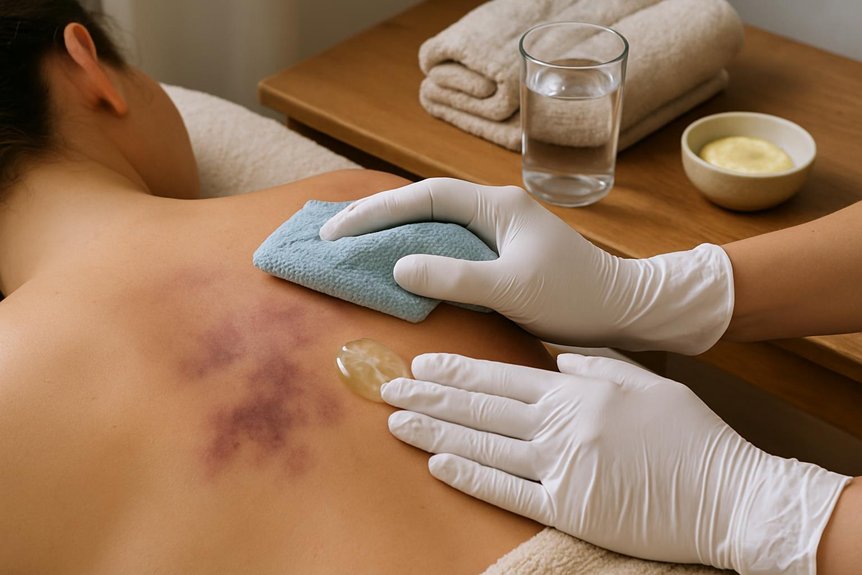
Following a therapeutic deep massage, Spa & Massage therapists recommend structured aftercare to minimise bruising risk, reduce soreness, and consolidate treatment gains.
Clients are advised to hydrate steadily over 24 hours to support microcirculatory clearance.
Gentle movement—such as walking or light stretching—maintains tissue glide without provoking inflammation.
Apply a cool compress for 10–15 minutes within the first few hours if tenderness or warmth arises; avoid direct ice on skin.
Warm showers the next day can ease residual stiffness.
Alcohol and vigorous workouts are deferred for 24–48 hours to prevent vasodilation and additional tissue stress.
In our clinics, therapists suggest magnesium-rich nutrition and, when appropriate, topical arnica.
Sleep quality is prioritised; a supportive pillow and unhurried breathing promote parasympathetic recovery.
When to Choose a Gentler Technique Instead
When tissue sensitivity, anticoagulant use, acute injury, or systemic fragility elevate bruising risk, a gentler technique is clinically indicated.
In such contexts, lighter-pressure modalities reduce capillary stress while still delivering analgesia and parasympathetic downregulation. At Spa & Massage, therapists prioritise graded pressure, slower pacing, and broader contact to modulate nociception without provoking tissue microtrauma.
Candidates for gentler work include clients early in a healing phase, those with connective tissue disorders, older adults with fragile skin, and anyone reporting post-session soreness exceeding 48 hours.
In practice, therapists often select Swedish-based strokes, myofascial glide without sustained compression, and aromatherapy massage with hypoallergenic oils to calm hyperalgesia.
Communication remains continuous; pressure is titrated to the client’s verbal and non-verbal cues, preserving comfort while achieving meaningful therapeutic change.
When to Seek Medical Advice or Adjust Future Sessions
Although mild, non-tender discoloration can be a normal response to deep tissue work, certain presentations warrant medical attention and adjustment of subsequent treatments. Seek medical advice if bruising is extensive, rapidly spreading, unusually painful, accompanied by swelling, warmth, numbness, weakness, shortness of breath, chest pain, or persistent bleeding.
Individuals on anticoagulants, antiplatelets, with clotting disorders, diabetes-related neuropathy, steroid use, or unexplained spontaneous bruising should consult a clinician.
For future sessions at Spa & Massage, therapists recommend lowering pressure, shortening session length, increasing intervals between appointments, and avoiding direct work over affected areas until fully resolved.
Applying brief, cool compresses within 24 hours and gentle mobility thereafter is advised. Clients should disclose medications, supplements, prior bruising, and comfort thresholds to refine a safe, effective plan.
Conclusion
In conclusion, therapeutic deep massage can relieve tension, can enhance mobility, and can aid recovery—yet it can, in specific contexts, cause bruising. By evaluating risk factors, by calibrating pressure, and by communicating continuously, clinicians at Spa & Massage minimise adverse effects. Clients who prepare thoughtfully, who follow targeted aftercare, and who select appropriate techniques are more likely to recover smoothly. When soreness is expected, when bruising is atypical, and when red flags appear, evidence-based guidance directs next steps and safeguards outcomes.
